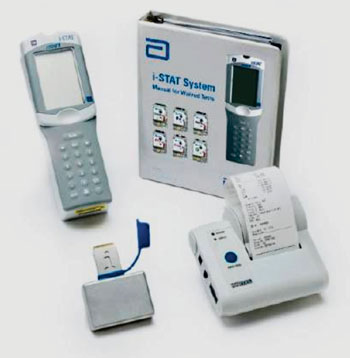Point-of-Care Capillary Whole Blood Hematocrit and Hemoglobin Compared
By LabMedica International staff writers
Posted on 15 Jun 2015
The clinical suitability of point-of-care devices for conductivity based point-of-care hematocrit with calculated hemoglobin necessitates that they be accurate and that the results are interchangeable with central laboratory methods.Posted on 15 Jun 2015
The appropriateness of conductivity based assays in certain patient populations, such as patients on cardiopulmonary bypass and those receiving high volumes of intravenous fluids or autologous blood transfusions, has been questioned.

Image: The i-Stat point-of-care system (Photo courtesy of Abbott Point of Care).
Clinical laboratory scientists at Massachusetts General Hospital (Boston, MA, USA) performed hematocrit and hemoglobin analysis on 225 clinical samples obtained from intensive care units and the cardiac surgery operating room. All samples were from adult patients over 18 years of age. The samples were first tested for clinical care and then immediately handed off to technologists for the study testing.
The total hemoglobin level was first measured by co-oximetry on the Siemens RAPIDLab 1265 analyzer (Siemens Medical Solutions USA, Inc.; Malvern, PA, USA). Hematocrit and hemoglobin values were obtained on the Abbott i-STAT instrument using one lot of i-STAT E3+ cartridges (Abbott Point of Care; Princeton, NJ, USA). Hemoglobin values from the i-STAT are performed by the calculation of directly measured hematocrit in percent × 0.34. A manual spun hematocrit was performed on each sample as the standard hematocrit reference method. The hematocrit and hemoglobin were also determined on the automated hematology analyzer XE5000 (Sysmex Corporation; Kobe, Japan) by impedance based cumulative pulse height detection and by photometric determination, respectively.
The i-STAT hematocrit and hemoglobin showed close agreement to comparison methods with minimal bias. Median test results were not clinically or statistically different between those measured on the i-STAT and those measured using the manual spun hematocrit reference method or the Sysmex photometric hemoglobin method. The results on the i-STAT were statistically significantly different from those obtained on the Sysmex for hematocrit and the Siemens RAPIDLab co-oximeter for hemoglobin.
The authors concluded that the i-STAT hematocrit and hemoglobin performs well when compared to the hematocrit reference method and other common methods for both hematocrit and hemoglobin. Some differences between non-reference methods may be observed, but these were not considered clinically significant. The study was published in the June 2015 issue of the journal Clinica Chimica Acta.
Related Links:
Massachusetts General Hospital
Siemens Medical Solutions USA
Abbott Point of Care













